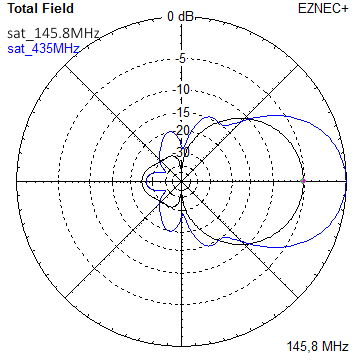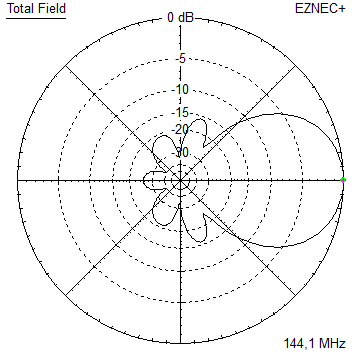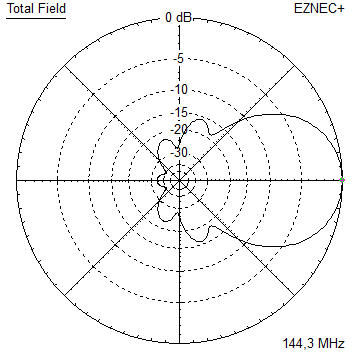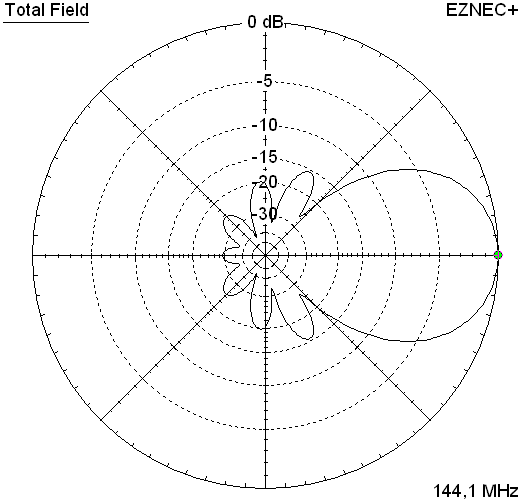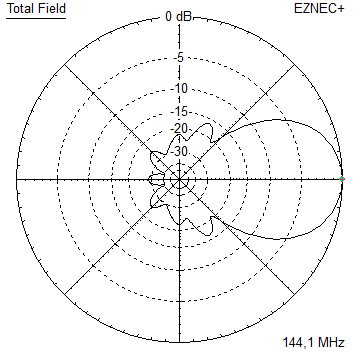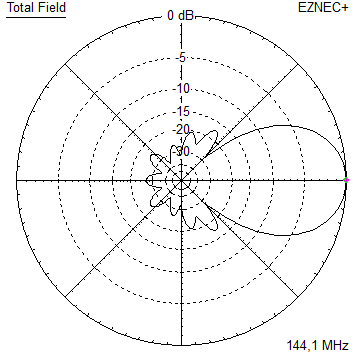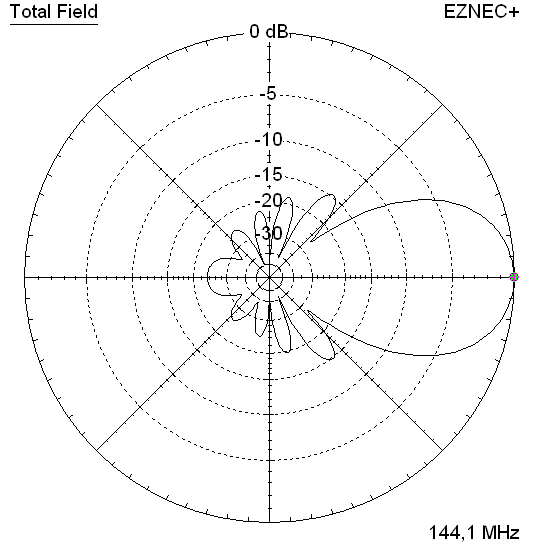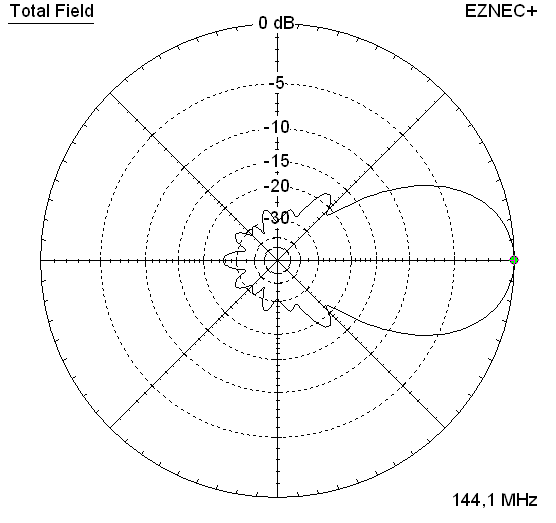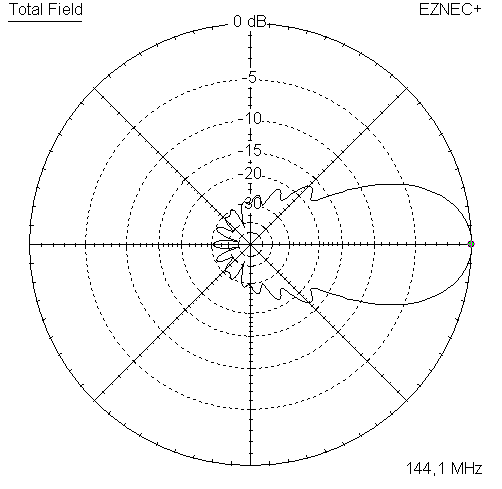




YBN 2-5m Yagi with Conventional Driver (Split or Folded Dipole)
This little Yagi has a high F/B, which makes it quite useful as a contest stack,
because the clean rear pattern is kept with stacked arrays.
Contest 4 x stack of YBN 2-5m, built by YO2LSP, used in 2020 IARU ctest by YO5LD/P
7th place in IARU Contest 2020 Single OP class. Congrats!

who succeeded an excellent results for the YO position. - 413 QSO`s , ODX - DA0FF @ 1028 km, Total: 192.955 points.
The antenna works fantastic, in special 2x11 element system. Thank you for your work." ... tnx Edy!
4 x vert. YBN 2-5m built by Zoran, E76C

4 x vert. YBN 2-5m at DL0GM built on 15 x 15 mm boom
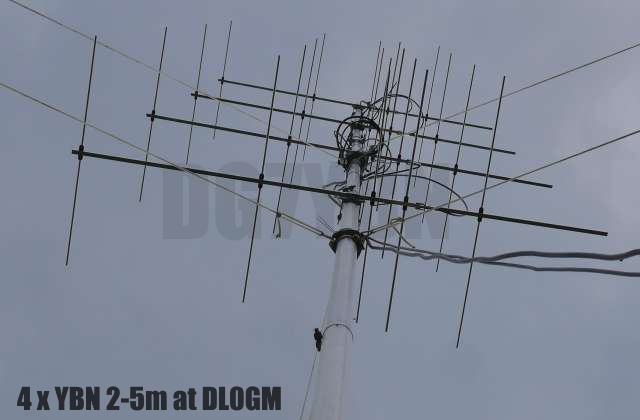
Update: Stacks with high F/B and CAD drawings as PDF for booms, struts and clamps see end of page


|
The YBN 2-5m is the very pilot model which was used to derive all the "On-Boom-BC-Factors" from (s. Dubus 2/2010). It has been measured about 50 times using various boom dimensions and element lengths. Finally for the 5-8 Yagi concept article (Dubus 4/2012) with folded dipole too. If you stick to the dimensions I give below and use the right i.e. measured symmetrising coax length you virtually can not fail with your build. On right : Stagger stacked 2 x 5 ele. (s. Dubus 1/2014) 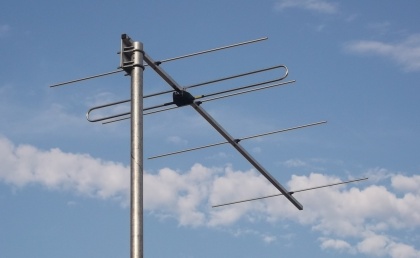
|

|

|
Sketch of boom with option to expand to 8 elem. / The additional 200+ mm on the rear enable mounting it formast as on
photo on left side. Note differing position of D1 when using thin through boom elements or folded dipole as given below.

Performance Data
Elem. 4 mm Elem. 5 mm Elem. 8 mm
Gain vs. isotr. Rad. 10.2 dBi 10.2 dBi 10.2 dBi
Gain vs. Dipole 8.0 dBD 8.0 dBD 8.0 dBD
-3 dB H-plane 73.0 deg. 72.8 deg. 73.2 deg.
-3 dB E-plane 54.8 deg. 54.6 deg. 54.8 deg.
F/B -24.9 dB -25.2 dB -24.8 dB
F/R -23.4 dB -23.4 dB -23.0 dB
Impedance 50/200 ohms = =
Mechan. Length 1485 mm = =
Electr. Length 0.74 λ = =
Stacking Dist. h-pol.
top-to-bottom 1.57 m
side-by-side 2.03 m
Geometry
EZNEC wires for 8 mm elements

Ø6 mm Elements - raw Dimensions exclusive BC
Refl DE D1 D2 D3 Pos. 0 283 403 822 1485 NEC x2 1028.0 992.0 956.4 930.5 861.0
Note: element lengths for Ø 8 mm fit 5/16" too
INSULATED THROUGH BOOM THIN ELEMENTS (BC acc. 6WU) Pos. 1/2 Length BC 20 mm BC 20 mm BC 25 mm BC 1" in NEC = 2.2 = 2.2 = 3.4 = 3.5 Refl. 0 514.5 1033.2 1031.2 1032.4 10xx.x DE 283 496.0 994.2 994.2 995.4 9xx.x D1 403 480.0 966.2 962.2 963.4 9xx.x D2 822 467.5 942.2 937.2 938.4 9xx.x D3 1485 433.5 875.2 869.2 870.4 8xx.x Ele.Ø 5 mm 4 mm 5 mm 5 mm 1/4" Use WiMo made spare Folded Dipole for their YU7EF line EF0208c or selfmade one with modified D1 as follows: Note: for elements 4 mm D1 is of differing length for 5 and 8 ele. Yagi when using a folded DE ele. 4 mm, Pos. 403 mm, NEC => 483.0, 20x20 => 968.2, 25x25 => 969.4 mm ele. 5 mm, Pos. 402 mm, NEC => 481.0, 20x20 => 964.2, 25x25 => 965.4 mm, 1"x1"=> 96x.x

ON BOOM ELEMENTS Pos. 1/2 Length BC 15x15 BC 20x20 BC 25x25 BC 1x1" BC 20x20 BC 25x25 in NEC = 2.7 = 3.9 = 7.6 = 7.9 = 3.9 = 7.6 Refl. 0 514.5 1031.7 1032.9 1036.6 1034.9 1031.4 1035.1 DE 283 496.0 994.7 995.9 999.6 999.9 995.9 999.6 D1 403 475.0 952.7 953.9 957.6 954.3 947.9 951.6 D2 822 461.0 924.7 925.9 929.6 925.9 918.9 922.6 D3 1485 423.8 850.3 851.5 855.2 851.5 844.9 848.6 Ele.Ø 8 mm 8 mm 8 mm 8 mm 3/8" 10 mm 10 mm
The Driver Dipoles diameter is 10 mm for all examples.
Use EZNEC's Auto-Segmentation at 144.3 MHz.
Use WiMo made Folded Dipole (spare from YU7EF line EF0208c)
or selfmade one with modified D1 as follows:
NEC => 477, Boom 20x20 => 957.9, Boom 25x25 => 961.6 mm, Boom 1"x1"=> 961.9
Folded Dipole
Folded DE tip-to-tip = 990, inner height = 54, diam. = 10 for all builds
Sketch of Folded Dipole
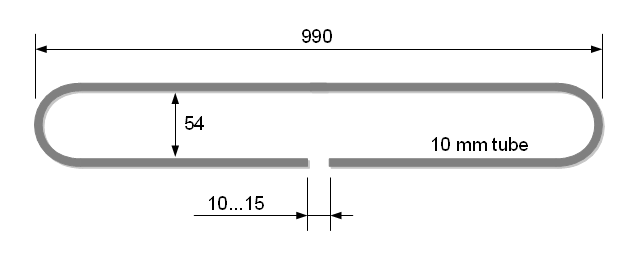
Overview on the stages of the YBN 5- 5 / 8 / 10 ele. project
Here is a very helpful overview on the stages of the YBN 5- 5 / 8 / 10 ele. project provided by Stef, F4EZJ (tnx!).
It shows what elements are shared and different at what positions on the boom for the various combinations
Note: Element lengths given fit elements mounted on a 20 x 20 mm boom with 'standard insulators and M3 screw
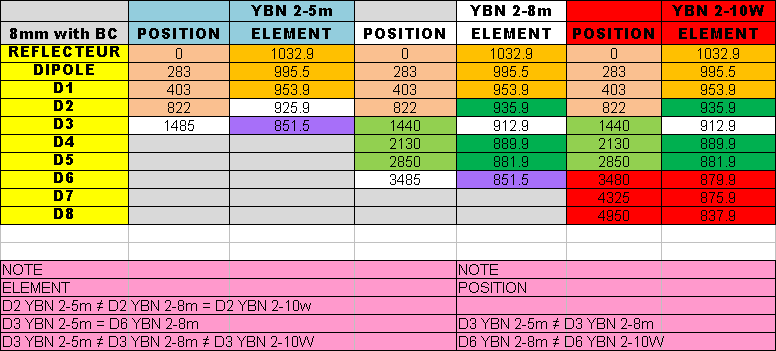
Pattern and VSWR Plots
Current distribution

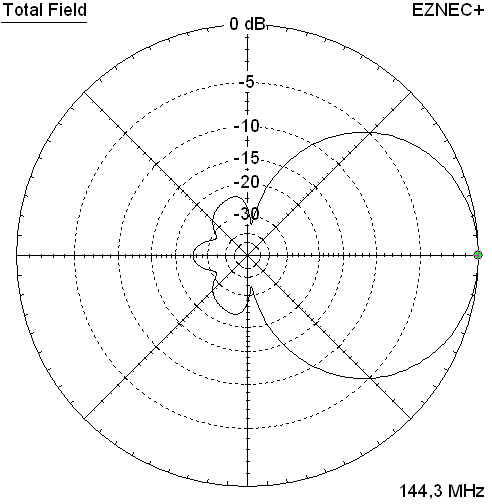

Return Loss and VSWR plot - Version with Folded Dipole from WiMo EF0208c

miniVNA: 144.40 MHz, Z = 49.6 Ohm, SWR = 1.03, RL = -36 dB

Note: this plot is taken on a build without any post tuning on DE or D1.
Just the "On-Boom-BC" added.
121.5 MHz Aircraft Emergency Frq. vers
Aircraft Emergency Frequency version built by F6ANQ and F6BKI.






Geometry for Boom 25 x 25 mm and elements held in hydraulic clamps on request.
Downloads
EZNEC file of this Yagi with Straight Split DE
Read more about building this Yagi in my Article "5-8 ... an extendable 144 MHz Yagi" in Dubus 4/12
Stacking
Stacking Dist. DL6WU Formula min. Side Lobes max. F/B H-plane 1.57 m 1.41 m 1.90 m E-plane 2.03 m 1.83 m 2.01 m
Data of 5 over 5 ele. Yagi stack using DL6WU stacking distances -10%

Gain vs. isotr. Rad. 12.7 dBi Gain vs. Dipole 10.6 dBD F/B -18.5 dB T_ant 236,0 K* G/T -11,01 dB*Theoretical numbers, no phasing line losses
nor imperfections caused by H-frame included
Data of 4 bay 5 ele. Yagi stack using DL6WU stacking distances -10%


Stacking Dist. DL6WU -10% DL6WU Gain vs. isotr. Rad. 15.8 dBi 16.1 dBi Gain vs. Dipole 13.7 dBD 14.0 dBD F/B -21.3 dB -24.3 dB F/R -26.2 dB -24.3 dB T_ant 231 K* 237 K* G/T -7.85 dB* -7.64 dB*Theoretical numbers, no phasing line losses
nor imperfections caused by H-frame included
(*) T_sky = 200 K, T_earth = 1000 K as in VE7BQH G/T table
Elevation plot and data of 4 Yagi vertcal bay using distances for max. F/B
Simulated over perfect ground

Free Space Data Over perfect gnd
Gain vs. isotr. Rad. 16.25 dBi 20.9 dBi
Gain vs. Dipole 14.10 dBD 18.8 dBD
F/B -27.5 dB -26.1 dB
Theoretical numbers, no phasing line lossesnor imperfections caused by H-frame included
Stagger Stacked Contest Array
These Yagis are stacked at 1.90 m and upper & lower Yagi in put 502 mm backwards.
The actual shift for this design stack of 502 mm is a little less than the principle 1/4 λ on 144.3 MHz.
Same as the proposed stacking distance of 1.90 m differs from the 1.57 m per DL6WU formular.
Why is that so?
The principle 1/4 λ is a number based on the theoretical concept of canceling backwards
source by a total of 180° of phase shift. But the individual directive Yagi-Uda antenna holds
phase shifts between parasitic elements and exciter (dipole) in itself. Thus best results for
increased F/B and F/R vary slightly. Same to the difference in vertical stacking distance to DL6WU.
A stacked arrays pattern is an intereference pattern of 2 or more sources i.e. Yagis. A stacking
scheme and goals apart from the standard longs for other optimum stacking distances.
Read abt. the principle here:
Photo: 4 x YBN 2-5m stacked at 1.90 m vertical and 502 mm inner shift



How to feed?
This idea goes back to Robi, S53WW's
"High Performance Antenna Stack for 2m Contest&Tropo Work", here
Read S53WW's web article or my article published in Dubus 1/2014 & Dubus Technik XIII for
full details of theory about stagger stacking and feeding with 1/4 λ phase lag into
the front Yagis. Note - line lenghts given hold no errors here, but a creative and proven
use of the periodicity of the sinus wave
Image Source Dubus 1/2014: DG7YBN, Stacking beyond DL6WU - Part 2

by the lenghts only, there is NO power splitter needed.
Basics - Impedance
• We take the upper two Yagis: Thats a 50 ohms plus another 50 ohms via 50 ohms coaxes.
Two times 50 ohms in parallel results in 25 ohms at their sum point.
• Then we do same with the lower pair of 50 ohms Yagis.
Two times 50 ohms in parallel results in 25 ohms at their sum point.
• Then we add these Two times 25 ohms in parallel via a transformation coax
consisting of any odd multiples of 1/4 such as 3/4, 5/4 ... wl of 50 ohms coax,
which transforms 25 ohms to 100 ohms in each line.
• Finally when these two lines of odd multiples of 1/4 wl meet, we get 50 ohms
from two times 100 ohms in parallel ... and we are done.
Basics - Phasing
The inner Yagis are displaced by 1/4 λ. To compensate this the feeding coaxes for the
inner Yagis must be are arranged for a phase lag of -90° compared to the outer Yagis. We will
name that phase correcting length 'L-plus'.
But: Feeding with a phase lag of -270° makes +90° as 360° - 270° = + 90° (periodicity of the sinus wave)
Prolonging the lines for the outer Yagis by 270° has same effect as feeding the inner Yagis with -90°.
So that instead of increasing the lengths of coax towards the inner Yagi by 90° of phase angle or 1/4 λ and
have those extra lengths hanging about on the pole with this little trick we can fit the -270° into the
lengths to the outer Yagis.
Phasing Coax Lengths
L_plus: We name that extra 270° length as L_plus in the sketch above. With a v-factor of 0.662 for PE coax it
is 1.031 m. The reason for this is to derive shortest possible feed lines up the pole instead of winding up phasing
lines for the inner Yagis as we see so often on vertical stacks.
L_1: L1 lengths are basically ANY length; but stay clear from any multiple of 1/4 λ x velocity factor.
L_2: L2 lengths are basically ANY odd multiples of 1/4 λ x velocity factor. Here they are 5 x 1/4 λ x V-factor.
At the sum point between 2 Yagis of 50 ohms impedance we find 25 ohms. Any odd multiple of 1/4 λ x velocity factor
brings that back to 50 ohms in the centre feed point. No splitter needed.
Total Lengths
Total lengths must include the lenghts inside likewise the N-T-joiners or whatever self made T-junctions.
Velocity Factor
Lengths L_plus, L1 and L2 given are for PE coax only!
For foam and air coax the effective velocity factor of these at 144 MHz must be applied.
See here
and here
Using 3 N-T-Pieces a flexible, easy to produce phasing line assembly is done at low costs.
Monster Stagger Stack tnx for suggestions to Alexey, RA4SD!
• Full CAD drawings for a 8 x vertical YBN 2-5w stagger stack for download now

• A brief study about a monster stack of 8 x vertical YBN 2-5w at narrow distances

Elevation Pattern (not optimised ... if you really think about a stack like this ask me for optimation of F/B if needed)

• A brief study about a monster stack of 8 x vertical YBN 2-5w at full distances
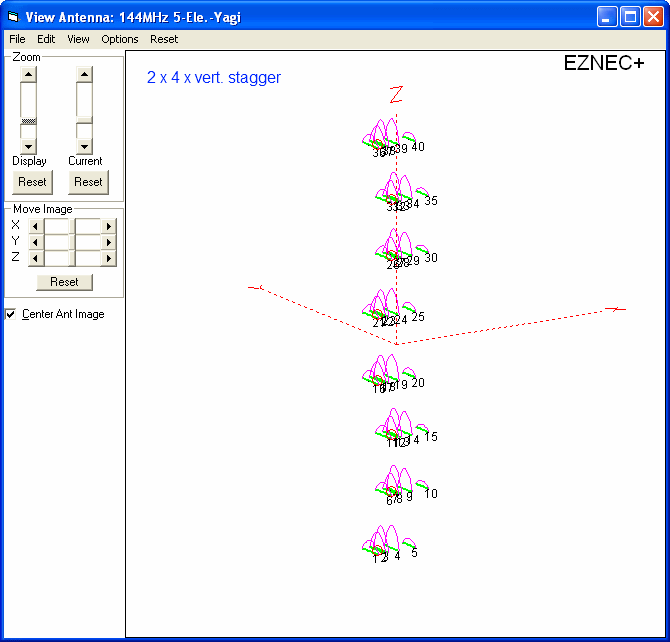
Elevation Pattern

• A monster stack of 8 x vertical YBN 2-5w at distances optimised for best directivity and F/B
• Geometrical shift between the Yagis is 502 mm
• Vertical stacking distance inside the 2 stacks is 1.90 m
• Vertical stacking distance between the 2 stacks is 3.10 m
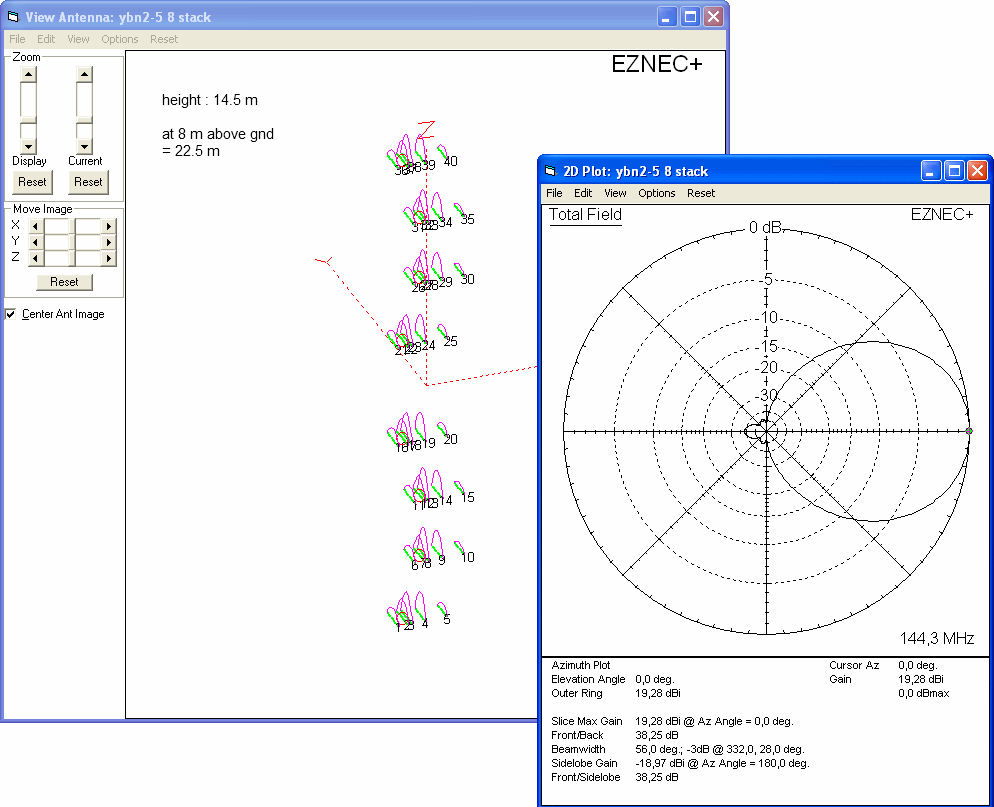
With such a rear pattern with a F/B of 38 dB but half power beam width of 56 degr. this stack
gives a good forcast for much less splatter received then most other options.
While this is a free space simulation lets see if the stack maintains this nice attribute when placed
above ground ...
Elevation Pattern above 'perfect ground'

Same on 3D thanks to the capable 3D viewer of 4nec2







Boom of Yagi in Position 0 mm for formast mounting
Boom of Yagi in Position 502 mm for formast mounting
Strut for Yagi in Position 0 mm for formast mounting
Strut for Yagi in Position 502 mm for formast mounting
Plates for mounitng strut to Yagi (same for both positions)
73, Hartmut, DG7YBN

